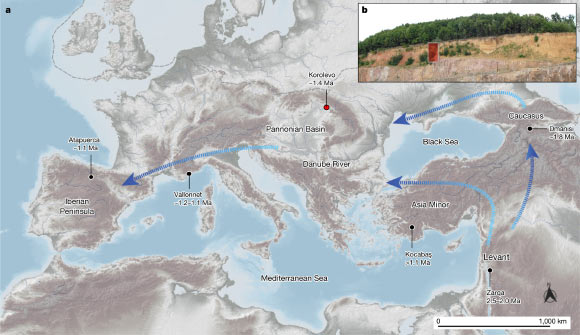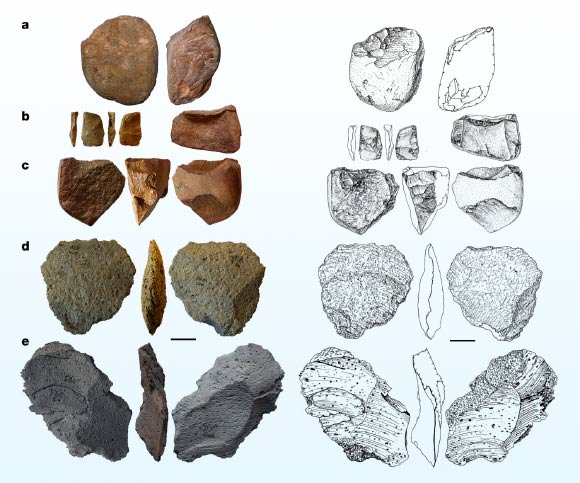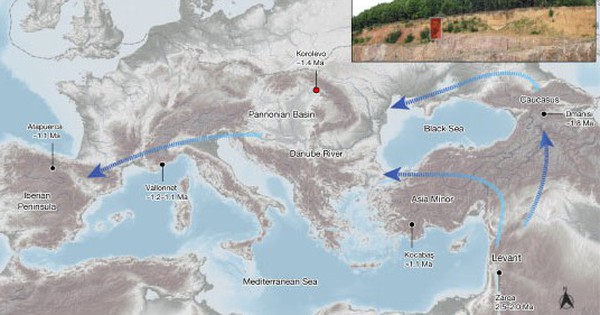1.42 Million-Year-Old Treasure Unearthed in Ukraine
Have you ever wondered about the earliest evidence of human presence in Europe? In a groundbreaking discovery, researchers in Ukraine have found a priceless archaeological treasure dating back 1.42 million years. Although it may appear to be just an ordinary stone at first glance, this artifact holds immense historical significance as it represents the earliest evidence of human presence in Europe. Let’s delve into this fascinating find together.
Unraveling the Mystery
This extraordinary treasure was unearthed at the Korolevo archaeological site, located on the banks of the Tysa River in Western Ukraine. The discovery supports the hypothesis that the European continent was invaded by humans from the East and Southeast, as reported by Sci-News. The artifact provides valuable insights into the migratory patterns of our ancient ancestors.

Image: A different human species laid the foundation for Europe’s exploration by traveling from West Asia through Ukraine, gradually moving westwards. (Photo: NATURE)
Tracing the Journey
To understand the significance of this discovery, we must retrace our steps back to the Dmanisi archaeological site in Georgia. Located in Eastern Europe, Dmanisi is home to sediment layers containing human skulls and stone tools dating from approximately 1.85-1.78 million years ago. According to TS Roman Garba from the Institute of Archaeology and Nuclear Physics at the Academy of Sciences of the Czech Republic, the migration route from Africa to Dmanisi, through the Levant corridor, aligns with the presence of Mode-1 stone tools in the Zarqa Valley of Jordan.
Jordan, situated at the crossroads between Asia and Africa, contains artifacts dating back approximately 2.5 million years, indicating its pivotal role in our ancestral journey.

Image: Stone tools discovered in Ukraine shed light on ancient civilizations. (Photo: NATURE)
Therefore, we can rewrite history as follows: a different human species from Africa migrated to Jordan before venturing deeper into the Levant region, which encompasses several modern-day Middle Eastern countries. From there, their journey continued to the present-day region of Georgia, spanning millions of years until they eventually reached Europe.
Homo Erectus: Architects of Change
The archaeological find in Ukraine reveals that the humanoid species responsible for crafting these stone tools is Homo erectus. This particular species belongs to the Homo genus, which encompasses up to 10 known species. While Homo sapiens, our own species, is the youngest member of this genus, Homo erectus is considered one of the oldest, with a presence on our planet dating back over 2 million years.
The Homo erectus species brought forth significant advancements that transformed the world into the diverse human civilization we know today. Notably, their ability to create stone tools using an “industrial” technique, passed down through generations with continuous improvements and refinements, is truly remarkable.
This is not the first time that treasures from another human species have emerged at the Korolevo site. The area is rich in raw materials that were essential to the Stone Age population. With a rich deposit spanning approximately 14 meters in depth, there is the potential for countless intriguing artifacts yet to be unearthed.
Over the years, excavations at the site have yielded artifacts from seven different periods, ranging from 30,000 years ago to the recently discovered 1.42 million-year-old treasure. The latest findings have been published in the scientific journal Nature.
As we continue to explore our past, discoveries like this shed light on the fascinating journey of our ancient ancestors. The artifacts unearthed in Ukraine not only elucidate early human history but also highlight the incredible ingenuity and progress achieved by Homo erectus. They are a testament to our shared human heritage and invite us to imagine the world as it once was, shaped by the remarkable civilizations that came before us.

